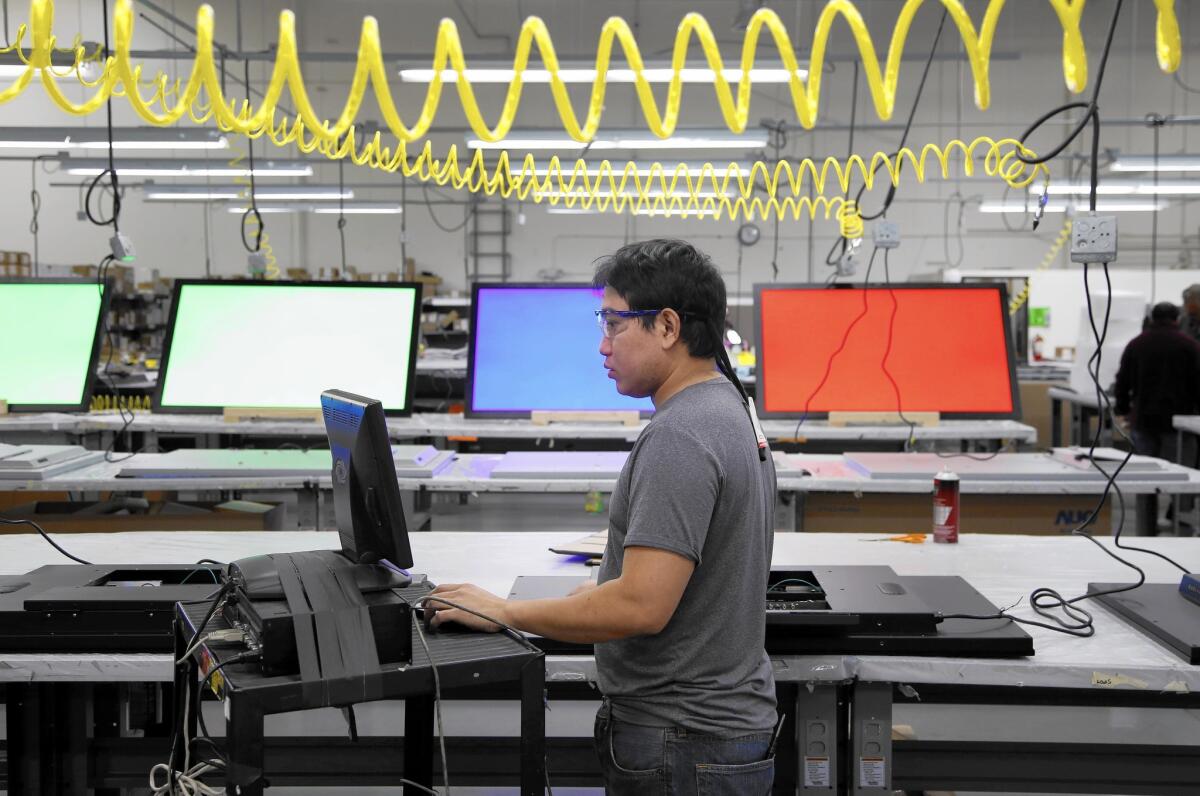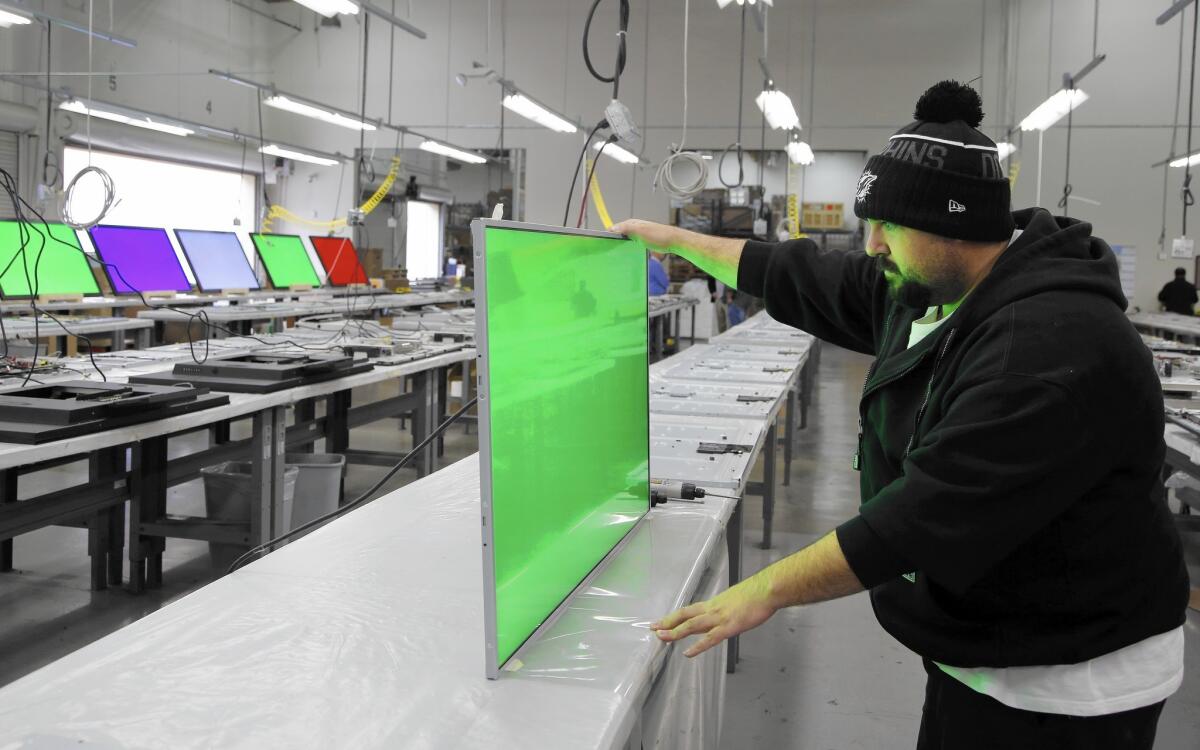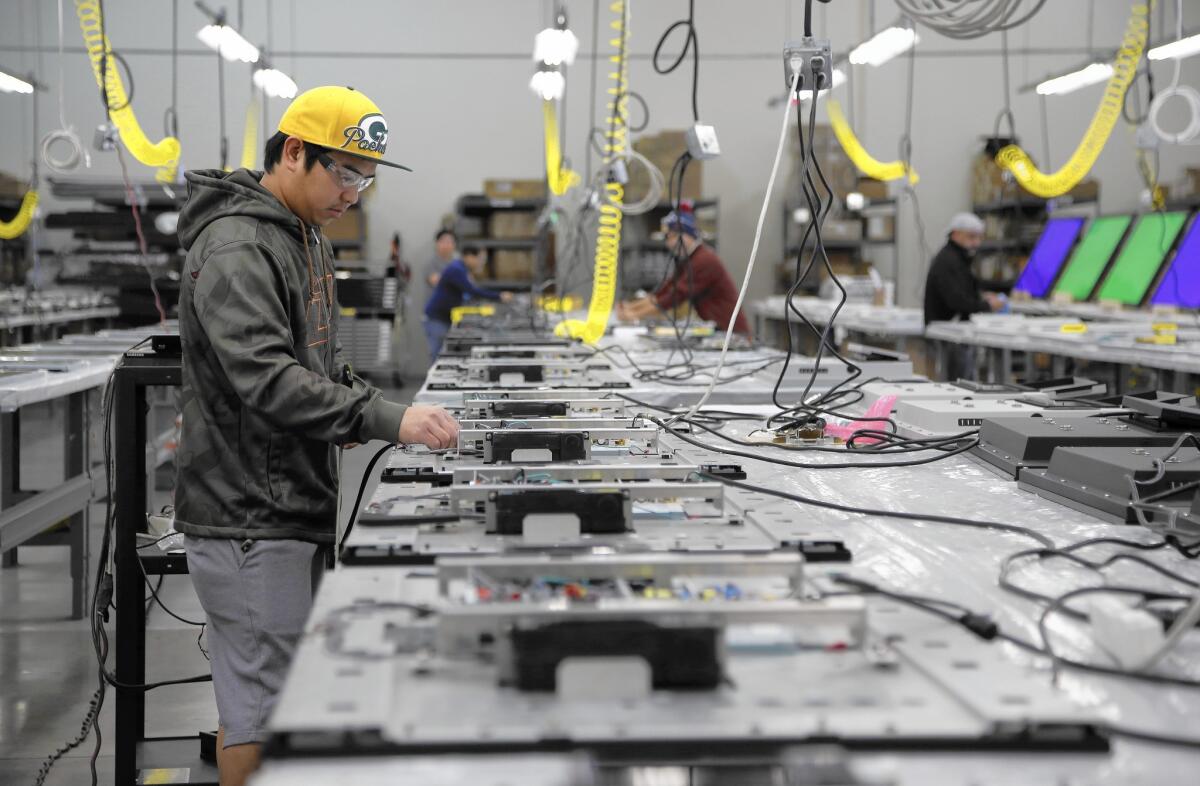SunbriteTV lights up the market for outdoor digital displays

SunBriteTV has had to become more efficient and maintain a brisk level of technological development to remain on top of the outdoor television market.
- Share via
University of Wisconsin officials wanted to please notoriously unruly Badgers football fans when they overhauled the team’s stadium, so they turned to SunBriteTV, a Newbury Park company that pioneered outdoor television and has kept its market-leading spot with endless product tinkering.
The school paid about $100,000 for 29 high-definition video displays bright enough to be seen in direct sunlight and tough enough to withstand Midwestern heat, humidity and snowstorms.
Adding the 55-inch SunBrite screens to Camp Randall Stadium in Madison, Wis., “allows our fans access to video they didn’t previously have, which is a critical part of the game-day experience,” said Justin Doherty, the university’s senior associate athletic director.
SunBrite’s recent sale is part of a boom in outdoor digital displays, a growing industry with more than $1.8 billion in sales, according to trade publication CE Pro. The pricey screens have become so popular in public spaces and private homes that their use has acquired its own nickname: techorating.

Ardee Maraon tests televisions in the SunbriteTV factory in Newbury Park.
SunBrite is “in one of the hottest industries, which is outdoor digital signage,” said Cameron E. Hill, who is interim chief executive as a new owner, SnapAV, takes over.
The products can play back the last touchdown, act as an electronic concierge or screen a film for guests in the backyard. They differ from indoor TVs in their picture clarity and ability to stand up to the elements outdoors.
SunBrite’s screens are designed and made by the company’s 60 employees and can be found locally at Disneyland, Dodger Stadium and the Huntington Library. Major casinos, cruise lines, zoos, parks and the military are customers.

SunBrite was acquired by private equity firm Bunker Hill Capital in 2011. Above, employee Tony Nuno tests a television.
SunBrite got its start in 2004, the brainchild of Larry Kaiser, who had spent decades manufacturing audio-visual products. His co-founder was an electro-mechanical engineer named Tom Weaver.
The two met at a country club and talked about how tired they were of watching sports on their indoor TVs on days when the weather was beautiful, Hill said.
Taking a traditional indoor set into the outdoors didn’t work well; viewers could barely see the picture because of the sunlight, and the set had to be rolled back in the house afterward because even a slight drizzle would wreck it.
“Their idea was to make a weatherproof, outdoor-rated television,” Hill said, “so that even in the worst climates, you could watch your sports games outside. Plus, it would be able to be permanently installed outside.”
Buyers usually were homeowners “who might have an outdoor kitchen, perhaps a swimming pool — everything but an outdoor TV,” Hill said.
But the commercial opportunities for outdoor video signage were soon apparent. In 2006, he said, “the Cincinnati Reds knocked on our door and said that they wanted to put digital signage in their stadium.”
SunBrite was first in what would become a crowded and competitive arena. Others with a global reach and deeper pockets have been entering the market, such as Samsung Electronics Co., Sharp Corp., Sony and Panasonic.
The head start has been crucial to SunBrite’s success, along with an emphasis on product innovation and vigorously seeking patent protection for their improvements, such as a 2011 airflow system to cool the LCD panel and allow longer exposure to direct sunlight. Three years later, SunBrite pushed through another cooling patent to improve the units’ ability to operate in extreme heat.

Michael Torres works on a television in the SunbriteTV factory in Newbury Park.
SunBrite is a private company that doesn’t reveal sales, but financial data company FactSet pegged the firm’s annual revenue at nearly $16 million. CE Pro says that SunBrite holds 57% of the residential market for outdoor televisions, with products that cost between $1,495 for a 32-inch screen and $8,900 to $9,895 for a 55-inch screen. A new 84-inch 4K ultra-high definition television hasn’t been priced yet.
SunBrite was acquired by private equity firm Bunker Hill Capital in 2011. Along with the new private equity ownership came demands for more efficiency and higher sales, to bring a quick return on Bunker Hill’s investment.
“Some things had to change in order to take advantage of the potential here,” said Hill, who joined SunBrite as CEO in 2012.
“There was very little sophistication,” Hill said. “Inventory was not identified by location, so you had people hunting for parts while the assembly line is waiting, idle, for their arrival.”
The company also changed the way the video displays were put together.
“Before parts were assembled one by one,” said Jonathan Dry, SunBrite’s senior mechanical engineer. “Now, it’s much more modular and there’s never a break in the assembly process.”
With the help of cross-training employees, a new supply chain and better access to inventory, the company “reduced assembly times by 40%,” Hill said. Sales have been growing at 20% a year since he came on as CEO, he said.
“And from an employee standpoint,” Hill added, “we’re not that far above the number we had when I started, 50 to 56, but we are producing three times as much product.”
There were design improvements, including switching from a plastic to an aluminum casing. Attention to detail was emphasized, such as weatherproofing parts and making sure screws and rubber washes fit snugly.
Dry said that his previous work at Nokia, where he was used to working with small smartphone screens, helped with the process.
“We were always told that if there was any air inside the phone, it was a bad design,” Dry said. Some new SunBrite designs allowed for thinner displays because “we took the air out.”
SnapAV, which makes and distributes audio, video and closed-circuit TV products, expanded into outdoor television and digital signage with its SunBrite acquisition in October for an undisclosed sum. “SunBriteTV is the unquestioned leader,” is profitable and growing fast, John Heyman, CEO of Charlotte, N.C.-based SnapAV, told employees in a memo.
Hill saw a particular advantage: lower prices to make SunBrite products more competitive.
“When dealers purchase SunBriteTV products at SnapAV, they will be direct from the manufacturer,” Hill said, delivering “value and service at significantly lower costs.”
Twitter: @RonWLATimes
More to Read
Inside the business of entertainment
The Wide Shot brings you news, analysis and insights on everything from streaming wars to production — and what it all means for the future.
You may occasionally receive promotional content from the Los Angeles Times.











